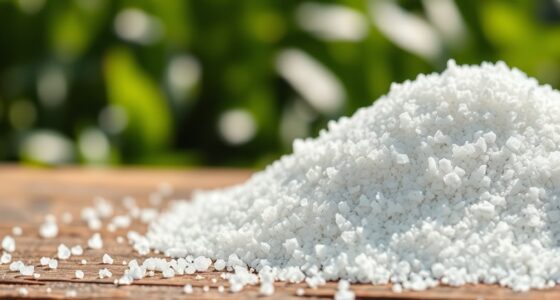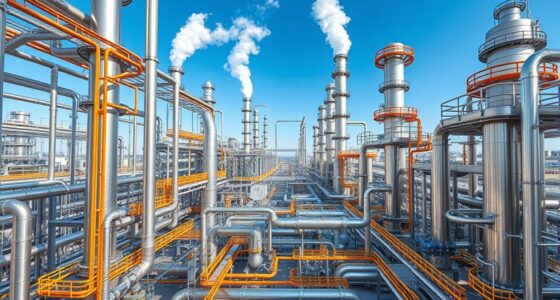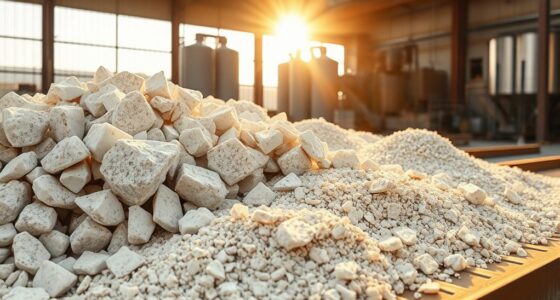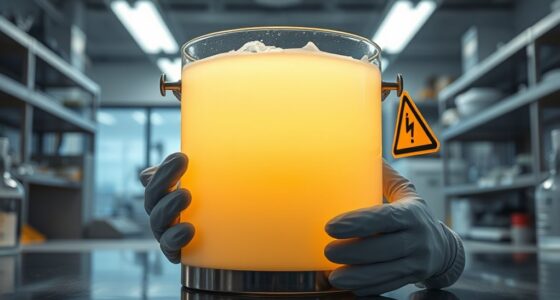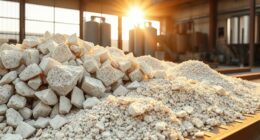Chlorine manufacturing starts with electrolysis of brine, where an electric current separates saltwater into chlorine gas, sodium hydroxide, and hydrogen. This efficient process is essential for producing chemicals used in disinfectants, plastics, and water treatment. Advances focus on improving energy efficiency and reducing environmental impacts, especially by using renewable energy. If you explore further, you’ll discover how these innovations help make chlorine production safer, greener, and more sustainable across industries.
Key Takeaways
- Chlorine is produced via electrolysis of brine, breaking down saltwater into chlorine gas, sodium hydroxide, and hydrogen.
- The electrolytic process involves passing electric current through saltwater, releasing chlorine at the anode.
- Technological advances improve energy efficiency and reduce environmental impacts of chlorine manufacturing.
- Managing by-products like hydrogen gas and brine waste is essential for safe and sustainable production.
- Chlorine’s industrial uses include disinfectants, plastics, pharmaceuticals, and water treatment, driven by advancements in production methods.

Chlorine manufacturing is a essential industrial process that produces chlorine gas, a key component in many everyday products. You might not realize it, but the way this gas is made relies heavily on electrolytic processes that break down brine—saltwater—into its basic elements. In this method, an electric current is passed through a salty solution, causing the chloride ions to release chlorine gas at the anode and sodium ions to form sodium hydroxide at the cathode. This process, known as electrolysis, is highly efficient and is the primary way chlorine is produced on a large scale today. Additionally, advancements in electrolytic technology aim to improve energy efficiency and reduce environmental impacts. However, you should be aware that electrolytic processes come with environmental impacts. The large-scale electrolysis of brine requires significant amounts of energy, often derived from fossil fuels, which contributes to greenhouse gas emissions. Additionally, the process can produce by-products like hydrogen gas, which, if not properly managed, can pose safety risks or lead to unintentional releases. The handling and disposal of brine waste are also concerns, as improper management can lead to water pollution and harm local ecosystems. These environmental impacts have prompted ongoing efforts to improve the sustainability of chlorine production, including developing energy-efficient electrolysis methods and recycling by-products where possible.
Despite these challenges, the importance of chlorine in industrial applications remains undeniable. Once produced, chlorine gas is essential for manufacturing a wide array of products, from disinfectants and plastics to pharmaceuticals and water treatment chemicals. Your everyday life benefits from chlorine-based products, but it’s essential to recognize the complex processes behind their creation. Advances in electrolytic technology aim to reduce the environmental footprint, making the process cleaner and more sustainable. For example, some facilities now integrate renewable energy sources to power electrolysis, decreasing reliance on fossil fuels and lowering emissions.
Frequently Asked Questions
What Are the Environmental Impacts of Chlorine Production?
You should know that chlorine production can impact the environment through potential chlorine leaks, which pose risks to water and air quality. However, using emission controls helps minimize harmful emissions during manufacturing. While these measures reduce environmental harm, leaks or accidents still threaten ecosystems. It’s essential for facilities to maintain strict safety protocols and advanced emission controls, ensuring production remains safer for the environment and nearby communities.
How Is Chlorine Transportation Safely Managed?
You guarantee chlorine transportation safety by strictly following transportation safety protocols, including proper container labeling, secure packaging, and regular inspections. Chlorine leak prevention is vital, so you use specialized tankers designed to withstand pressure and prevent leaks. Additionally, you coordinate with emergency responders and adhere to regulations to minimize risks. These measures help protect both people and the environment during chlorine transit.
What Innovations Are Improving Chlorine Manufacturing Efficiency?
Imagine your factory as a well-oiled machine, humming with innovation. Catalyst advancements act like turbochargers, speeding up reactions and boosting efficiency. Process optimization fine-tunes each step, reducing waste and energy use like a master chef perfecting a recipe. These innovations work together, transforming chlorine manufacturing into a smoother, faster operation, helping you produce more with less, all while cutting costs and environmental impact.
How Does Chlorine Production Differ Globally?
You’ll notice that chlorine production varies globally due to regional disparities and supply chain complexities. In some regions, electrolysis is the main method, while others rely on alternative processes like the mercury cell or membrane cell technology. These differences affect production costs, environmental impact, and availability. Understanding these disparities helps you grasp how local resources, regulations, and infrastructure shape the global chlorine supply chain.
What Are Future Trends in Chlorine Industry Technology?
Imagine a river carving a new path, shaping the landscape ahead—this is how future chlorine tech evolves. You’ll see more advanced catalysts speeding up processes and membrane technology creating cleaner, more efficient electrolysis. These innovations will reduce energy use and environmental impact, making chlorine production smarter and more sustainable. Embracing these trends, you’ll help build a resilient industry that adapts seamlessly to global demands and greener practices.
Conclusion
Now that you understand how chlorine is produced from brine electrolysis, think of the journey from simple saltwater to essential industrial applications. It’s fascinating how a basic process transforms into products that clean water, disinfect hospitals, and manufacture plastics. Just as pure saltwater becomes chlorine, your knowledge turns complex chemistry into everyday essentials. So, next time you see chlorine’s many uses, remember the powerful, yet simple, process that made it all possible.


